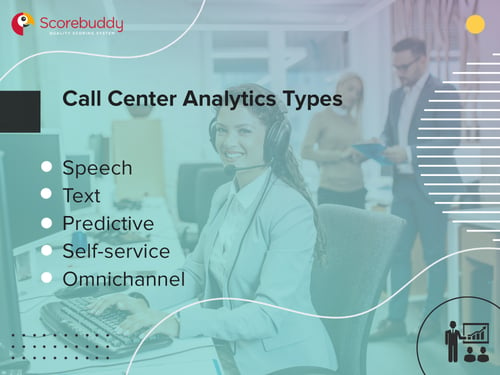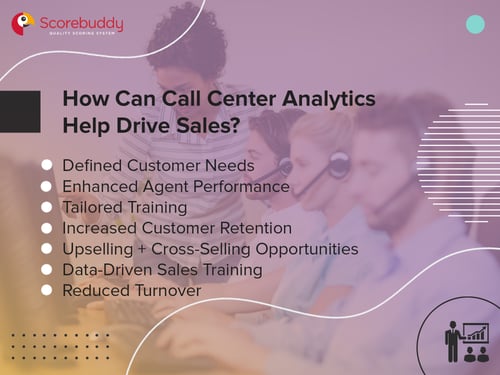Contact centers process huge amounts of data on a daily basis. Using analytics tools, you can make sense of all this unstructured data and turn it into clear, actionable insights.
By collecting and analyzing data from every customer interaction, you can determine the best ways to improve customer experience, operational efficiency, and agent performance, reducing costs and increasing revenue.
With 91 percent of large companies planning to increase their investment in big data and AI, gathering and analyzing customer insights will play a significant role in the future of the contact center industry.
These customer insights will contribute significantly to revenue generation, allowing for more accurate market segmentation and a better understanding of consumer needs, wants, and behaviors.
There are several different types of call center analytics that provide greater insights into real-time and historical data, including speech, text, predictive, self-service, and omnichannel.
Speech analytics uses AI to identify keywords, patterns, tone, and more in voice-based interactions like phone and video calls, voicemail messages, and IVR menu responses. This allows call center leaders to identify trends around customer sentiment, average handle time, and more. These tools can even provide real-time warnings when a conversation takes a negative turn.
Given that nearly 70 percent of customers still prefer to seek help with a purchasing decision over the phone, speech analytics remains a key component of call center data analysis.
Call centers process a huge amount of text every day, from emails and text messages to surveys and social media. Using AI, text analytics can identify patterns, finding connections between different data points to extract insights into sentiment, language, emotion, and more.
Text analytics is powered by neural language processing (NLP) and machine learning, reviewing every text channel to give a full overview of your contact center’s customer experience. Perhaps a certain phrase in your script frequently turns customer sentiment negative—text analytics will spot this trend.
Understanding the customer is essential to a successful contact center. By using predictive analytics, you can interpret past consumer data to generate insights into future behavior, preferences, and demands.
Predictive analytics software collects all data from historical interactions, processing this information and generating predictive models to support future operations. You could, for example, determine peak hours and seasons to ensure adequate staffing at these times or pinpoint areas of compliance risk to mitigate chances of a future regulatory lapse.
In 2023, most organizations supplement their customer service offerings with self-service tools like chatbots and knowledge bases, and 81 percent of consumers state that they would like even more self-service options.
By using analytics tools, you can gather and interpret data from self-service channels like blogs, eBooks, and FAQs. In doing so, you can determine ways to improve your self-service options. For example, if analytics highlights frequent queries about shipping times, you could update your FAQ to clarify the shipping process.
Omnichannel is here to stay, with nearly three-quarters of customers seeking the ability to switch channels while speaking to a customer service agent. By implementing omnichannel analytics, you can examine data from every single channel to generate a comprehensive overview of the customer journey.
This allows for detailed insights into the efficacy of each channel, so you can then segment and personalize your CX according to customer needs. By understanding when a customer chooses live chat over a phone call, for example, you can streamline the process to provide quicker, more satisfactory resolutions.

By gathering and analyzing customer data, call center analytics tools can create additional revenue generation opportunities through a greater understanding of customer needs, stronger agent performance, and improved insights into the actions that cement conversions.
90 percent of customers are more likely to buy from a company that understands their goals. Analytics tools allow you to step into customers’ shoes, so you can use this knowledge to inform sales and CX strategies. This way, you can clearly define expectations using real-time data and make better, faster decisions to meet customer needs.
Without AI analytics, the task of analyzing every interaction would be overwhelming. Take customer surveys, for example. While they have always been an important method of gathering feedback, analytics tools allow you to pull every possible insight from the responses, maximizing the learning value with minimal effort. If you know exactly what customers need, your sales conversion rates will improve.
Data can be the secret ingredient to improve KPIs and boost agent productivity. In fact, research finds that data analytics can help companies improve productivity by 60 percent. With call center analytics, you can pinpoint the metrics that have the greatest impact on your business goals and eliminate the inefficient processes and unnecessary tasks that damage these KPIs.
Using AI, you can automatically tag and review tickets and interactions, freeing up your agents to focus on customer queries. This way, you can reduce the workload for agents while improving metrics like first call resolution and average handle time. If agents are better equipped to deliver exceptional CX, customers will be more receptive to sales pitches.
Identifying skill gaps is a key aspect of the training process. By assessing your agents’ relative strengths and weaknesses, you can provide targeted training and coaching that makes a tangible difference to performance and productivity.
With analytics and reporting tools allowing you to break down interactions by topic, issue, customer sentiment, and more, you can derive actionable insights and link performance to the KPIs most relevant to your business goals. You can even track these metrics in relation to specific agents, so you can measure the impact of training over time.
From a sales perspective, this allows you to pinpoint the techniques and approaches that are driving conversions and deliver tailored training programs based on these findings.
With 70 percent of consumers willing to spend more with companies that offer a personalized customer experience, it’s essential that you use all the data at your disposal to enhance CX and retain customers. Analytics tools allow you to identify behavioral patterns on micro and macro levels, so you can personalize CX, cement loyalty, and streamline workflows.
To personalize CX, you could compile a customer profile using demographic information and determine the customer’s preferred channel of communication based on previous interactions. On a broader scale, AI analytics can uncover trends in interaction volume, allowing you to boost CX by offering self-service opportunities at appropriate times, auto-routing calls to the most relevant agents, and ensuring sufficient staffing during peak periods.
Existing customers are an important source of revenue generation, so it’s important that you do everything you can to keep them on board.
With analytics, you can predict future customer behavior based on demographic information and purchase patterns, informing your sales strategy. You can identify the times, days, and methods of communication each customer prefers and deliver personalized product recommendations and targeted promotions based on their interests.
Analytics can even highlight opportunities for upselling and cross-selling in real time during an interaction, notifying agents so they know when to take action. Improved data analysis also allows for more accurate performance-based bonuses, motivating agents to raise their game and deliver more conversions. Additionally, through customer feedback analysis, you can pinpoint any pricing issues and rectify them swiftly.
Using analytics software, you can identify the most pressing issues impacting your call center and deliver targeted agent training.
For sales training, in particular, analytics will provide you with real-world examples that you can use to coach agents. You can use successful instances to develop guidelines, teach them how to adjust their language based on customer sentiment, and encourage them to implement techniques that have worked successfully in the past.
Research finds that the average cost of turning over a single call center rep is $14,113. What’s more, it takes new agents time to get up to speed—their lack of familiarity with your product and processes could be costly in terms of sales too.
The insights offered by data analysis can improve the accuracy of evaluations, enhance the quality of training, and reduce the chances of agent stress and burnout. All of these factors contribute to better morale and, as a result, stronger agent retention.
By incorporating more data in your evaluations, you can eliminate bias and ensure the fairest possible assessment, encouraging agents to stick around longer and, ultimately, keeping your top performers positioned to continue driving sales.
Using predictive analytics, you can identify volume trends and ensure adequate staffing, reducing the chances of overwhelmed agents. The gathering and analysis of data over time also serve to inform the training process, ensuring that your agents are clear on their targets and equipped with the skills they need to do their job effectively

When implemented effectively, analytics tools can transform unstructured contact center data into clear, actionable insights. You can use a variety of analytics tools—text, speech, predictive, and more—to gather and analyze information from every agent-customer interaction and use this analysis to enhance CX, streamline workflows, and improve performance, opening up further opportunities for sales and revenue generation.
Using a purpose-built QA tool like Scorebuddy, you can gather all of your interaction data in a central hub, allowing you to access cross-channel analytics that provides a comprehensive overview of your organization. Click the button below to try out Scorebuddy’s analytics and reporting functionality.